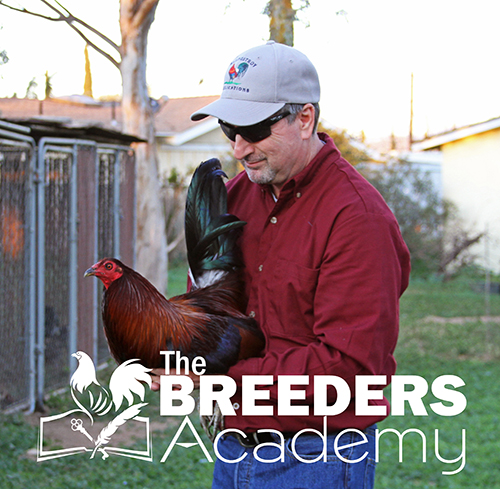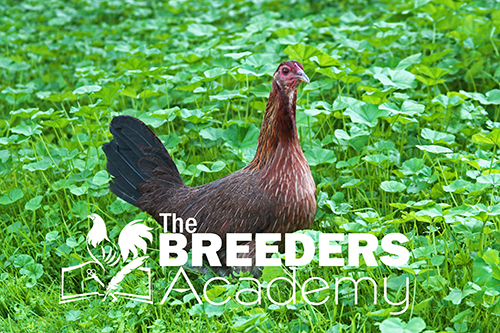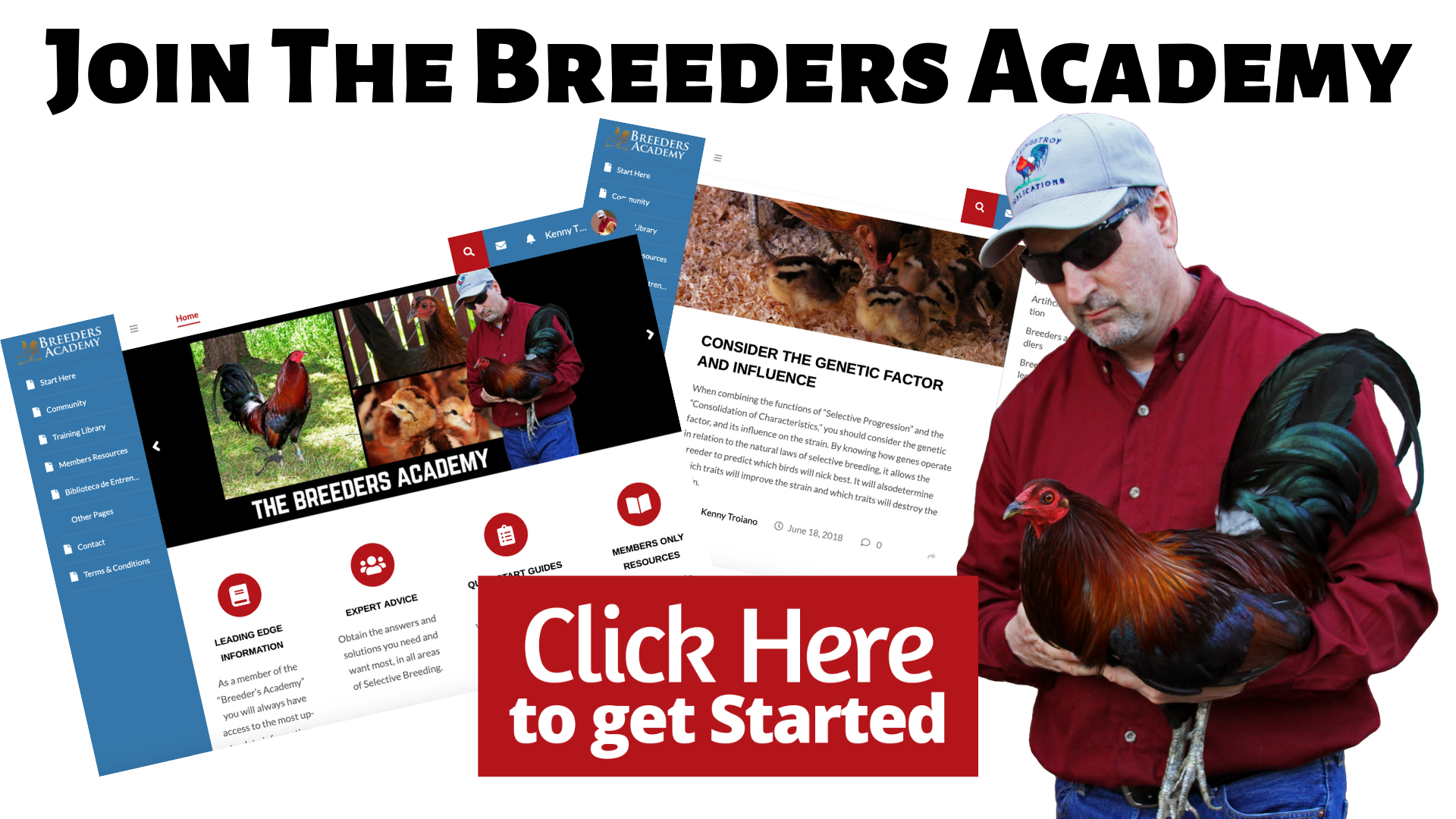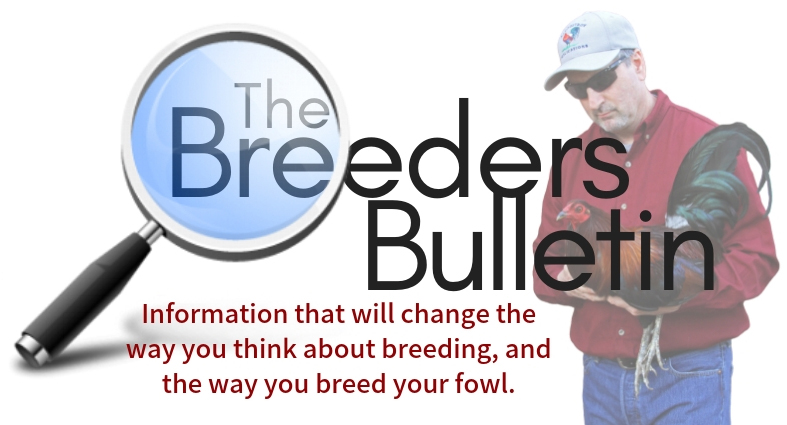
By Kenny Troiano
There are many ways to purchase fowl, but the best way to purchase potential foundation fowl is in person. The reason I mention this, again and again, is that I get so many calls from those who have purchased fowl through the mail, and were extremely disappointed.
By making a personal visit to the breeder’s farm, it gives you the opportunity to check out the breeders operation, and make sure his fowl are healthy. Also, by making a personal visit, it gives you the opportunity to be sure his broodfowl are good representatives of American Games.
As you visit with the breeder, to select your new fowl, (1) examine the cleanliness and condition of his farm, (2) examine the health and condition of his fowl, (3) make sure the fowl are good representatives of American Games, and are free of defects, (4) evaluate his knowledge and expertise as a breeder, and finally, (5) watch out for breeders who breed and raise multiple breeds and strains.
Let’s look at each of these points a bit closer:
The Cleanliness of his Farm:The condition of the breeder’s farm, and how well he manages it, will tell you a lot about this breeder. A chaotic farm usually means a chaotic breeding program, or no breeding program at all. A breeder that has a clean, well-managed farm, most likely has fowl that are healthy and well-bred.

The Health and condition of his fowl: you cannot build a family on a foundation of sick chickens. If you see any sick or lethargic chickens on his farm, even one, don’t buy anything from that breeder. Politely excuse yourself, and leave, as soon as possible. Go home – wash your clothes and shower really well.
A sick chicken should never be used in the brood pen. Even if they recover, they will most likely be carriers of the disease, and there is a good possibility the disease will occur once again. Most sick birds become chronic, which means the disease will occur again and again. If you should bring home a bird that was once sick, your chickens will most likely contract the disease. Once they contract the disease, they will continue to pass it to their offspring every year.
I would also be especially suspicious of anyone who says they vaccinate their chickens every year. There is a reason they vaccinate, because their chickens have been exposed to that particular disease. Vaccinating your fowl for disease will not eradicate the disease, it only hides it. There is only one vaccination I will permit, before buying his fowl and that is for Fowl Pox.
The Quality of his fowl: As you select from the available fowl on his farm, take your time and fully evaluate their overall quality and worth. Remember, you are selecting potential broodfowl. They will be the foundation to your new strain, if there are any faults, your new strain will have them as well.
- First, look at them carefully as they walk and fly in their pen. Study their movements and visible characteristic. For instance:
- Do they look healthy and energetic?
- Do they have any noticeable defects?
- Do they walk and fly elegantly and gracefully?
- Do they have the proper color of plumage and conformation of body?
- Do they have the characteristics and traits you desire?
- Second, pick the birds up. How is their temperament and overall disposition? How do they feel in the hand – light and thin or heavy and fat? And, are they soft or “corky”? (corky is a term used to explain a birds body condition, one that is light in the hand but well fleshed and hard bodied)
His expertise in breeding: While you are at it, ask the breeder questions about the breed and particularly his fowl. If the breeder is knowledgeable and experienced, it will show. If he is a breeder you can trust, he will hopefully enlighten you of the particularities and characteristics of his fowl, and what to expect in the future.
What the breeder has to say about his fowl is important, for the reason that – “not all fowl are the same,” and the breeder may have some valuable advice that only he knows, information that will get you off to a good start.
How many breeds and strains does he raise? The best breeders I know only breed and raise one or two breeds or strains, three at the most. They know that raising too many breeds inhibits their ability to improve their lines.
If you visit a breeder who has more than two or three breeds or strains, there’s a good chance he’s a peddler. I don’t know of anyone who can properly manage multiple breeds or strains.
I raise one family of fowl, and have done so for many years. I made the most progress once I got rid of all the other breeds.
- By concentrating all my effort into one family, and utilizing all my broodpens for the advancement of that family, I was able to make rapid improvement.
- By single-mating my best birds, and creating five separate lines within the family, I was able to create just enough genetic diversity to prevent Inbreeding Depression.
- By utilizing all my broodpens with just one family, I was able to producing a large number of offspring, which gave me plenty of individuals to select from.
- By doing this, I quickly noticed the vast improvement in my fowl, and they continue to improve each and every year.
Breeders, who raise multiple breeds and strains, cannot maintain and improve their lines as well as a breeder who only raises one or two. My advice is to be cautious of any breeder who breeds and raises more than two or three breeds and strains.
Special note of interest: For a more detailed description of what to look for – see chapters concerning color of plumage, conformation of body, and identifying defects.
Not all breeders will let you visit their farm: There are times when it is impossible to purchasing fowl in person. Some are highly suspicious, and other are commendable. For instance:
- The breeder lives too far away, many times in another state.
- The breeder doesn’t sell his broodfowl, only the offspring produced by the broodfowl, but the customer only wants the broodfowl, wasting the breeder’s time.
- And, then there are those who fear the theft of their fowl. By inviting those who may want to steal his birds in the night.
- There are also those who breed and raise substandard fowl, and don’t want anybody to find out the truth.
- On the other hand, there are those who don’t allow visitors onto their farm, due to strict biosecurity measures. Their fowl are valuable and therefore irreplaceable, and they fear the introduction and infection of disease, which is spread by contaminated clothes or shoes.
I too am very cautious of whom I let on my yard. I have a family of fowl that cannot be replaced. Also, I am very aware of the lackadaisical attitude others have when it comes to biosecurity. There are too many breeders out there who have “open yards.” Their fowl either carry a disease or have been exposed to disease. Very few breeders practice proper biosecurity, and if I’m not careful, their problems could quickly become my problem. The disease’s I fear most are Coryza and Laryngotracheitis, not to mention Newcastle Disease and Cholera. Once these pathogens make their way onto your yard, they are almost impossible to eliminate.
Determining the value of your newly purchased fowl: To determine the value and worth of your newly purchased broodfowl, you first need to breed them. As you breed them, study their offspring for weaknesses. This includes resistance to diseases, and identifying their most common defects. Evaluate the desirable traits and traits that need eliminating. Also, evaluate their performance ability.
As you breed them, ask yourself, “Are the offspring better than their parents?” A good family or strain should show continued improvement, each and every breeding season. In fact, the offspring should be better than their parents every year, beginning with their first breeding.
Once you are convinced that the fowl you have purchased are of the highest quality, breed them in such a way that you will ensure their continued improvement. For example, make sure all substandard and sick fowl are culled and eliminated, and that you are only breeding the top ten percent. In time, this will bring about a higher average for the entire family. This can only be accomplished by breeding from the healthiest birds, and constantly selecting and culling, beginning at hatching and continuing the process right into maturity, keeping only the best for future breeders.
When I talk with gamefowl breeders, from all over the world, about the art and science of gamefowl breeding, they all share one thing in common, and that is, they want to produce high quality strains that are true representatives of their breed, and have superior performance ability. They are sick and tired of buying poor quality birds, and are forced into beginning with hybrid crosses. We I’m here to tell you that I can show you have to create a true strain with fowl that are not related. Breeding gamefowl that are uniform and consistent is the best approach and not as hard as you may think. The Breeders Academy was created for breeders like you, breeders that take pride in their fowl, and want to take control of their breeding results. Join us at www.breedersacademy.com. To get started, go to the upper menu and click the “Become a Member” tab. I am there to help you get started.
Hope you enjoyed the article, and thanks again for reading.
Join us at the BREEDERS ACADEMY, and learn how to create a true strain, one that you can be proud of. I will help you to increase your knowledge of breeding, advance your skills as a breeder, and help you to improve the quality and performance of your fowl. I’m confident that if you follow my advice, your fowl will improve. So, check it out – https://americangamefowlbreedersacademy.com
Also, be sure to check out our new Podcast, called “Bred to Perfection” – a show for the serious breeder.
Make sure to sign up for our Breeders Bulletins (weekly newsletters)
Yours truly, Kenny Troiano
Author of the Gamefowl Breeders Manuals
Owner of the Breeders Academy Membership Website
And, Host of the Bred to Perfection Podcast
Visit us atwww.breedersacademy.com

